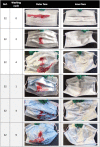Impact of washing cycles on the performances of face masks
- PMID: 36530797
- PMCID: PMC9749850
- DOI: 10.1016/j.jaerosci.2021.105914
Impact of washing cycles on the performances of face masks
Abstract
The tension on the supply of surgical and FFP2 masks during the first wave of the COVID-19 pandemic leads to study the potential reuse of these masks. As washing is easily adaptable at home, this treatment solution was retained. In this work, thirty-six references of surgical masks and four FFP2 masks were tested without being worn or washed and after several washing cycles. The results highlighted a great heterogeneity of performances depending on the mask trademarks, both for surgical masks and FFP2. The quality of the meltblown and spunbond layers and the presence/absence of electrostatic charges at the fiber surface are put forward to explain the variability of results, both on differential pressures and filtration efficiencies. The differential pressure and the particle filtration efficiency of the washed masks were maintained up to 10 washing cycles and met the standard requirements. However, an immersion in water with a detergent induces an efficiency decrease for submicronic particles. This lower performance, constant after the first washing cycle, can be explained by the loss of electrostatic charges during the washing cycle. The modifications of surface properties after washing also lead to a loss of the hydrophobic behavior of type IIR surgical masks, which can therefore no more be considered as resistant to blood projections.
Keywords: Electrostatic charge; FFP2; Reuse; Surgical masks; Washing.
© 2021 Elsevier Ltd. All rights reserved.
Conflict of interest statement
The authors declare that they have no known competing financial interests or personal relationships that could have appeared to influence the work reported in this paper.
Figures










Similar articles
-
Impact of washing parameters on bacterial filtration efficiency and breathability of community and medical facemasks.Sci Rep. 2022 Sep 23;12(1):15853. doi: 10.1038/s41598-022-20354-w. Sci Rep. 2022. PMID: 36151269 Free PMC article.
-
On the durability of surgical masks after simulated handling and wear.Sci Rep. 2022 Mar 23;12(1):4938. doi: 10.1038/s41598-022-09068-1. Sci Rep. 2022. PMID: 35322142 Free PMC article.
-
Protection Level and Reusability of a Modified Full-Face Snorkel Mask as Alternative Personal Protective Equipment for Healthcare Workers during the COVID-19 Pandemic.Chem Res Toxicol. 2021 Jan 18;34(1):110-118. doi: 10.1021/acs.chemrestox.0c00371. Epub 2020 Dec 17. Chem Res Toxicol. 2021. PMID: 33331780
-
Effect of washing on quality, breathability performance and reusability of disposable face masks.J Med Eng Technol. 2022 Jul;46(5):345-353. doi: 10.1080/03091902.2022.2043476. Epub 2022 Mar 21. J Med Eng Technol. 2022. PMID: 35311595
-
Functionalized Masks: Powerful Materials against COVID-19 and Future Pandemics.Small. 2021 Oct;17(42):e2102453. doi: 10.1002/smll.202102453. Epub 2021 Jul 28. Small. 2021. PMID: 34319644 Free PMC article. Review.
Cited by
-
Evaluation of the Microbiological Effectiveness of Three Accessible Mask Decontamination Methods and Their Impact on Filtration, Air Permeability and Physicochemical Properties.Int J Environ Res Public Health. 2022 May 27;19(11):6567. doi: 10.3390/ijerph19116567. Int J Environ Res Public Health. 2022. PMID: 35682153 Free PMC article.
-
Impact of washing parameters on bacterial filtration efficiency and breathability of community and medical facemasks.Sci Rep. 2022 Sep 23;12(1):15853. doi: 10.1038/s41598-022-20354-w. Sci Rep. 2022. PMID: 36151269 Free PMC article.
-
An Experimental Analysis of Five Household Equipment-Based Methods for Decontamination and Reuse of Surgical Masks.Int J Environ Res Public Health. 2022 Mar 11;19(6):3296. doi: 10.3390/ijerph19063296. Int J Environ Res Public Health. 2022. PMID: 35328984 Free PMC article.
-
Can disposable masks be worn more than once?Ecotoxicol Environ Saf. 2022 Sep 1;242:113908. doi: 10.1016/j.ecoenv.2022.113908. Epub 2022 Jul 21. Ecotoxicol Environ Saf. 2022. PMID: 35872486 Free PMC article.
-
Guidelines for measuring and reporting particle removal efficiency in fibrous media.Nat Commun. 2023 Sep 1;14(1):5323. doi: 10.1038/s41467-023-41154-4. Nat Commun. 2023. PMID: 37658063 Free PMC article.
References
-
- Agarwal G., Perwuelz A., Koehl L., Lee K.S. Interaction between the surface properties of the textiles and the deposition of cationic softener. Journal of Surfactants and Detergents. 2012;15:97–105. doi: 10.1007/s11743-011-1273-4. - DOI
-
- Alcaraz J.-P., Le Coq L., Pourchez J., Thomas D., Chazelet S., Boudry I., Barbado M., Silvent S., Dessale C., Antoine F., Guimier-Pingault C., Cortella L., Rouif S., Bardin-Monnier N., Charvet A., Dufaud O., Leclerc L., Montigaud Y., Laurent C.…Landelle C. Reuse of medical face masks in domestic and community settings without sacrificing safety: Ecological and economical lessons from the Covid-19 pandemic. Chemosphere. 2022;288:132364. doi: 10.1016/j.chemosphere.2021.132364. - DOI - PMC - PubMed
LinkOut - more resources
Full Text Sources
Research Materials
Miscellaneous
